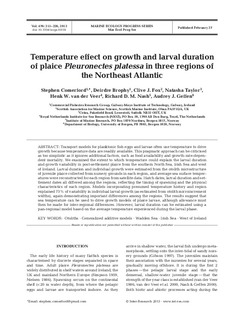Temperature effect on growth and larval duration of plaice Pleuronectes platessa in three regions of the Northeast Atlantic
Comerford, Stephen; Brophy, Deirdre; Fox, Clive J.; Taylor, Natasha; van der Veer, Henk W.; Nash, Richard D.M.; Geffen, Audrey J.
Journal article, Peer reviewed
Permanent lenke
http://hdl.handle.net/11250/109253Utgivelsesdato
2013-02-27Metadata
Vis full innførselSamlinger
- Articles [3012]
Originalversjon
Comerford S, Brophy D, Fox CJ, Taylor N, van der Veer HW, Nash RDM, Geffen AJ (2013) Temperature effect on growth and larval duration of plaice Pleuronectes platessa in three regions of the Northeast Atlantic. Mar Ecol Prog Ser 476:215-226 10.3354/meps10118Sammendrag
Transport models for planktonic fish eggs and larvae often use temperature to drive growth because temperature data are readily available. This pragmatic approach can be criticised as too simplistic as it ignores additional factors, such as food availability and growth-rate-dependent mortality. We examined the extent to which temperature could explain the larval duration and growth variability in post-settlement plaice from the southern North Sea, Irish Sea and west of Ireland. Larval duration and individual growth were estimated from the otolith microstructure of juvenile plaice collected from nursery grounds in each region, and average sea surface temperatures were reconstructed for each region from satellite data. Hatch dates, larval duration and settlement dates all differed among the regions, reflecting the timing of spawning and the physical characteristics of each region. Models incorporating presumed temperature history and region explained 73% of variability in individual larval growth (as estimated from otolith microincrement widths), again demonstrating important differences among the regions. The results suggest that sea temperature can be used to drive growth models of plaice larvae, although allowance must then be made for inter-regional differences. However, larval duration can be estimated using a pan-regional model based on the average temperature experienced during the larval phase.
